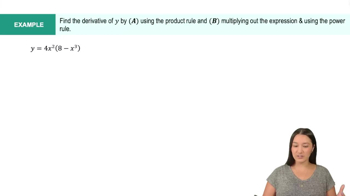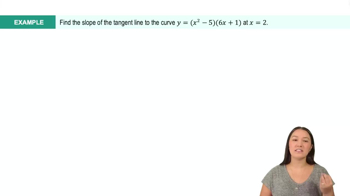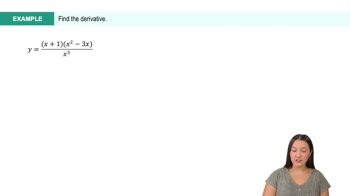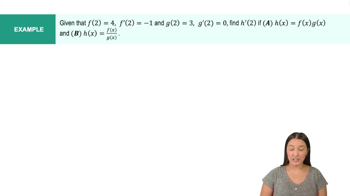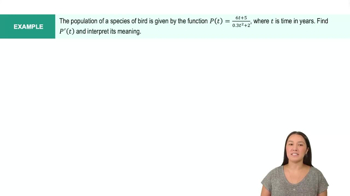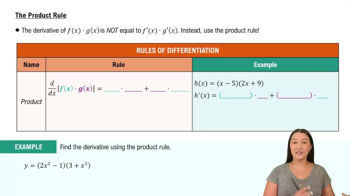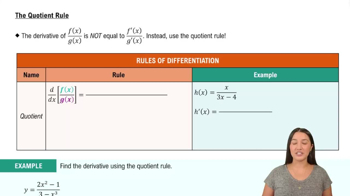Table of contents
- 0. Functions7h 52m
- Introduction to Functions16m
- Piecewise Functions10m
- Properties of Functions9m
- Common Functions1h 8m
- Transformations5m
- Combining Functions27m
- Exponent rules32m
- Exponential Functions28m
- Logarithmic Functions24m
- Properties of Logarithms34m
- Exponential & Logarithmic Equations35m
- Introduction to Trigonometric Functions38m
- Graphs of Trigonometric Functions44m
- Trigonometric Identities47m
- Inverse Trigonometric Functions48m
- 1. Limits and Continuity2h 2m
- 2. Intro to Derivatives1h 33m
- 3. Techniques of Differentiation3h 18m
- 4. Applications of Derivatives2h 38m
- 5. Graphical Applications of Derivatives6h 2m
- 6. Derivatives of Inverse, Exponential, & Logarithmic Functions2h 37m
- 7. Antiderivatives & Indefinite Integrals1h 26m
- 8. Definite Integrals4h 44m
- 9. Graphical Applications of Integrals2h 27m
- 10. Physics Applications of Integrals 2h 22m
3. Techniques of Differentiation
Product and Quotient Rules
Problem 96
Textbook Question
{Use of Tech} Beak length The length of the culmen (the upper ridge of a bird’s bill) of a t-week-old Indian spotted owlet is modeled by the function L(t)=11.94 / 1 + 4e^−1.65t, where L is measured in millimeters.
a. Find L′(1) and interpret the meaning of this value.
 Verified step by step guidance
Verified step by step guidance1
First, identify the function given: L(t) = \frac{11.94}{1 + 4e^{-1.65t}}. This is a rational function where the numerator is a constant and the denominator is a function of t.
To find L'(t), we need to differentiate L(t) with respect to t. This requires using the quotient rule for differentiation, which states that if you have a function \frac{u(t)}{v(t)}, its derivative is \frac{u'(t)v(t) - u(t)v'(t)}{(v(t))^2}.
In our case, u(t) = 11.94 and v(t) = 1 + 4e^{-1.65t}. The derivative of u(t), u'(t), is 0 because it is a constant. For v(t), apply the chain rule to find v'(t). The derivative of 4e^{-1.65t} is -6.6e^{-1.65t} (using the chain rule).
Substitute these derivatives into the quotient rule formula: L'(t) = \frac{0 \cdot (1 + 4e^{-1.65t}) - 11.94 \cdot (-6.6e^{-1.65t})}{(1 + 4e^{-1.65t})^2}. Simplify the expression to find L'(t).
Finally, evaluate L'(1) by substituting t = 1 into the derivative expression. This value represents the rate of change of the culmen length at t = 1 week, indicating how quickly the length is increasing at that specific time.
 Verified video answer for a similar problem:
Verified video answer for a similar problem:This video solution was recommended by our tutors as helpful for the problem above
Video duration:
3mPlay a video:
Was this helpful?
Key Concepts
Here are the essential concepts you must grasp in order to answer the question correctly.
Derivative
The derivative of a function measures the rate at which the function's value changes as its input changes. In this context, L'(t) represents the instantaneous rate of change of the culmen length L with respect to time t. Calculating L'(1) will provide insight into how quickly the beak length is growing at t = 1 week.
Recommended video:

Derivatives
Exponential Function
The function L(t) includes an exponential term, e^(-1.65t), which influences the growth behavior of the beak length over time. Exponential functions are characterized by their rapid increase or decrease, depending on the sign of the exponent. Understanding this concept is crucial for interpreting how the beak length evolves as the owlet ages.
Recommended video:
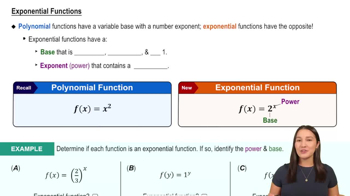
Exponential Functions
Interpretation of Derivatives
Interpreting the value of a derivative involves understanding its practical significance in a real-world context. For L'(1), this means analyzing what the calculated rate of change indicates about the growth of the owlet's beak at one week old, such as whether it is growing rapidly, slowly, or not at all, which can have implications for the bird's development.
Recommended video:

Derivatives
Related Videos
Related Practice



